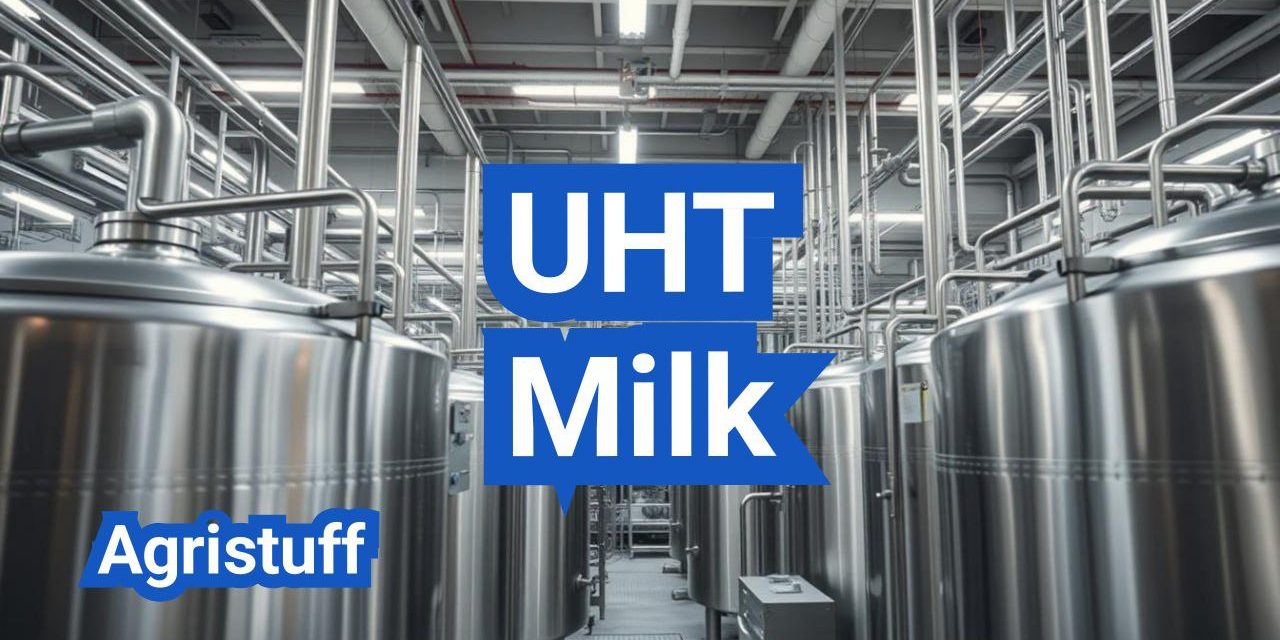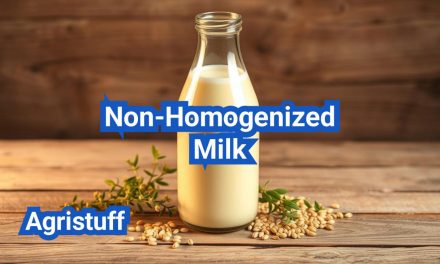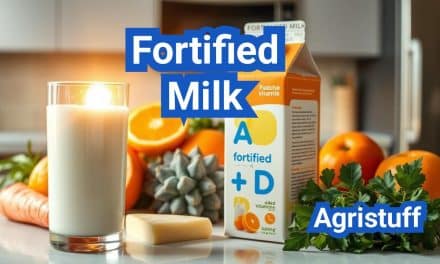Ultra-High Temperature (UHT) processing gives milk a shelf life of several months without refrigeration. This is achieved by heating the milk to a very high temperature for a short period, followed by rapid cooling, resulting in commercial sterility.
UHT milk is packaged in aseptic containers that prevent the entry of bacteria and other contaminants, making it a convenient option for consumers who want to stock up or for areas where refrigeration is not readily available.
This process results in shelf-stable milk that is perfect for emergency supplies or outdoor activities.
Key Takeaways
- UHT milk is ultra-pasteurized for a longer shelf life.
- Aseptic packaging prevents bacterial contamination.
- UHT milk can be stored at room temperature for several months.
- It’s a convenient option for stocking up or areas without refrigeration.
- UHT processing results in commercial sterility.
What Is UHT Milk? Understanding Ultra-High Temperature Processing
Understanding UHT milk begins with grasping the concept of Ultra-High Temperature processing, a method that revolutionizes milk preservation. UHT milk is made by heating milk to a very high temperature, usually around 138°C, for a short period, typically about 2 seconds, followed by rapid cooling. This process extends the milk’s shelf life significantly.
The Full Form and Definition of UHT
UHT stands for Ultra-High Temperature. The full form of UHT refers to the process of heating milk to an ultra-high temperature to kill off harmful bacteria and extend its shelf life. This method ensures that the milk remains safe for consumption over a longer period without refrigeration.
Brief History of UHT Milk Development
The history of UHT milk dates back to the 1960s when it was first developed as a method to extend the shelf life of milk. The technology was designed to address the need for milk preservation in regions where refrigeration was not readily available. Over the years, UHT processing has evolved, becoming more efficient and widely adopted globally.
Global Popularity vs. U.S. Market Presence
UHT milk has gained significant popularity worldwide, especially in regions where access to refrigeration is limited. Countries in Europe, Asia, and Latin America have widely adopted UHT milk due to its convenience and long shelf life. However, its presence in the U.S. market is relatively limited compared to other parts of the world. Despite this, UHT milk is slowly gaining traction in the United States, particularly among consumers looking for convenient and long-lasting dairy products.
The Science Behind UHT Milk Processing

Understanding UHT milk processing requires a look into the science that makes it possible. UHT processing involves heating milk to a very high temperature for a short period, ensuring the milk becomes commercially sterile while preserving its nutritional value.
Temperature Requirements: How Hot Is “Ultra-High”?
The temperature requirement for UHT processing is typically around 138°C or higher, maintained for at least 2 seconds. This ultra-high temperature is crucial for achieving the desired level of sterility without significantly affecting the milk’s quality.
Direct Steam Injection Method
One of the primary methods used in UHT processing is direct steam injection. This involves injecting steam directly into the milk to heat it rapidly to the required temperature. The direct steam injection method is efficient and helps in preserving the nutritional properties of the milk.
Indirect Heating Method
The other main method is indirect heating, where the milk is heated through a heat exchanger. This method also achieves the high temperatures necessary for UHT processing while maintaining the quality of the milk. Indirect heating is often preferred for its ability to control the temperature precisely.
Both methods are designed to achieve the same goal: to produce milk that is safe for consumption and has a long shelf life without refrigeration. The choice between direct steam injection and indirect heating depends on the specific requirements of the manufacturer and the desired characteristics of the final product.
UHT Milk vs. Other Milk Types: Key Differences
UHT milk stands out from other milk types due to its unique processing method and extended shelf life. This distinction is primarily due to the ultra-high temperature processing that UHT milk undergoes, setting it apart from traditional pasteurized milk, fresh milk, and even Extended Shelf Life (ESL) milk.
UHT Milk vs. Traditional Pasteurized Milk (HTST)
The primary difference between UHT milk and traditional pasteurized milk lies in their processing temperatures and the resulting shelf lives. Traditional pasteurized milk is heated to a lower temperature (usually around 161°F) for a shorter duration (typically 15 seconds), known as High Temperature, Short Time (HTST) pasteurization. In contrast, UHT milk is heated to a much higher temperature (usually around 280°F) for a brief period (typically 2 seconds).
Key differences include:
- Shelf life: UHT milk can be stored for several months without refrigeration, while traditional pasteurized milk must be refrigerated and consumed within a shorter timeframe.
- Nutritional content: While both types of milk are nutritious, UHT processing can slightly affect certain vitamins.
- Taste: UHT milk may have a slightly different taste due to the Maillard reaction caused by high heat.
UHT Milk vs. Fresh Milk
Fresh milk, often referred to as raw milk, is not heat-treated, preserving its natural enzymes and some argue, its natural flavor. However, this lack of heat treatment means it has a very short shelf life and requires strict handling and storage.
Comparison points:
| Characteristics | UHT Milk | Fresh Milk |
|---|---|---|
| Processing | Heated to 280°F for 2 seconds | No heat treatment |
| Shelf Life | Several months unrefrigerated | Very short, requires refrigeration |
| Safety | Commercially sterile | Risk of containing harmful bacteria |
Extended Shelf Life (ESL) Milk: The Middle Ground
ESL milk is processed to have a longer shelf life than traditional pasteurized milk but is not as long-lasting as UHT milk. It is typically pasteurized at a higher temperature than HTST but lower than UHT, or it may be microfiltered.
ESL milk characteristics:
- Longer shelf life than HTST milk but shorter than UHT milk.
- May be processed using ultra-pasteurization or microfiltration.
- Often has a fresher taste than UHT milk due to lower processing temperatures.
How to Identify UHT Milk in Stores

The key to identifying UHT milk lies in its packaging and the information on its label. When shopping, consumers can look for specific characteristics that distinguish UHT milk from other types of milk.
Common Packaging Types and Labels
UHT milk is typically packaged in aseptic containers, such as cartons or bottles, designed to prevent bacterial contamination. These containers are often aseptic cartons or specially designed bottles that maintain the milk’s sterility.
Labels on UHT milk products may indicate “UHT” or “Ultra-Pasteurized,” signaling that the milk has undergone ultra-high temperature processing. This labeling is crucial for consumers who prefer or require UHT milk.
Where to Find UHT Milk in U.S. Supermarkets
In U.S. supermarkets, UHT milk can usually be found in the dairy section or sometimes in a separate area for long-life or specialty milks. It’s often stocked alongside other types of milk and dairy alternatives.
Consumers can check the dairy case or the shelf designated for milk products. Some stores may also carry UHT milk in their international or ethnic food sections, particularly if there’s a demand for it from specific communities.
Reading UHT Milk Labels and Expiration Dates
Understanding the labels and expiration dates on UHT milk is essential for ensuring the product’s quality and safety. The expiration date or “Best By” date indicates the last day the product is considered fresh and of high quality when stored properly.
For UHT milk, the expiration date can be quite long due to its sterilization process. Consumers should check the packaging for any visible signs of damage or tampering and always store the milk according to the manufacturer’s instructions.
Nutritional Profile of UHT Milk
The nutritional content of UHT milk is comparable to that of traditional milk, with some minor differences. UHT processing has a minimal effect on the nutritional quality of milk.
Macronutrient Composition
UHT milk retains its macronutrient composition, including protein, fat, and carbohydrates, similar to regular milk.
- Protein Content: UHT milk contains high-quality protein essential for muscle repair and growth.
- Fat Content: The fat content in UHT milk can vary depending on the type (whole, low-fat, or skim).
- Carbohydrates: Lactose, a natural sugar, is present in UHT milk, providing energy.
Vitamin and Mineral Content
UHT milk is a good source of various vitamins and minerals, although some water-soluble vitamins like vitamin C may be slightly reduced during processing.
- Calcium: Essential for bone health, UHT milk is a rich source of calcium.
- Vitamin D: Often fortified with vitamin D, UHT milk supports bone health and immune function.
- Other Nutrients: UHT milk contains other essential nutrients like potassium and magnesium.
Effects of UHT Processing on Nutrients
While UHT processing involves high temperatures, it has a minimal impact on the overall nutritional content. Some sensitive vitamins may be affected, but the loss is relatively minor.
The Remarkable Shelf Life of UHT Milk

One of the most significant advantages of UHT milk is its extended shelf life, making it a convenient option for consumers. This characteristic is particularly beneficial for those who shop less frequently or live in areas with limited access to fresh milk.
Unopened Shelf Life: How Long Does It Really Last?
Unopened UHT milk can last for several months when stored properly. The exact duration depends on factors such as storage conditions and the packaging of the milk.
- Typical Shelf Life: Most UHT milk products have a shelf life ranging from 6 to 9 months.
- Factors Affecting Shelf Life: Exposure to heat, light, and oxygen can affect the quality and shelf life of UHT milk.
Proper Storage of Unopened UHT Milk
To maximize the shelf life of unopened UHT milk, it’s essential to store it in a cool, dry place away from direct sunlight. A pantry or cupboard is an ideal location.
- Keep the milk away from heat sources and direct sunlight.
- Store the milk in a cool, dry place.
- Avoid storing UHT milk near strong-smelling foods, as it can absorb odors.
Opened UHT Milk: Storage Guidelines and Expiration
Once opened, UHT milk should be treated similarly to regular milk. It needs to be refrigerated and consumed within a few days.
- Refrigeration: Store opened UHT milk in the refrigerator at a temperature below 40°F (4°C).
- Consumption: Consume the milk within 7 to 10 days after opening.
- Check for Spoilage: Always check the milk for signs of spoilage before consumption, such as an off smell or curdling.
How to Store and Use UHT Milk Properly

Proper storage and handling of UHT milk ensure its shelf-stable convenience is fully utilized. To maintain its quality and extend its shelf life, it’s essential to follow the right storage practices.
Best Storage Practices for Unopened Containers
Unopened UHT milk containers should be stored in a cool, dry place, away from direct sunlight. This could be a pantry or cupboard. It’s crucial to keep them away from heat sources and maintain a consistent storage temperature.
Handling and Refrigeration After Opening
Once opened, UHT milk requires refrigeration to prevent spoilage. It’s recommended to store opened UHT milk in the refrigerator at a temperature below 40°F (4°C). After opening, UHT milk should be consumed within 7 to 10 days for optimal taste and quality.
Signs of Spoilage to Watch For
Before consuming UHT milk, whether opened or unopened, it’s vital to check for signs of spoilage. These include an off smell, slimy texture, or curdling. If you notice any of these signs, it’s best to discard the milk to avoid foodborne illness.
By following these storage and handling guidelines, you can enjoy UHT milk at its best quality and safety.
Taste and Quality Considerations of UHT Milk

The ultra-high temperature processing of UHT milk gives it a unique flavor profile that some consumers find appealing. This distinct taste is primarily due to a chemical reaction that occurs during the processing.
The Maillard Reaction: Why UHT Milk Tastes Different
The Maillard reaction is a chemical reaction between amino acids and reducing sugars that occurs when milk is heated to high temperatures. This reaction is responsible for the slightly different flavor and color of UHT milk. The Maillard reaction contributes to the formation of new flavor compounds, resulting in a taste that is often described as slightly sweeter or more caramel-like.
Tips for Adjusting to the Flavor Profile
For consumers who are new to UHT milk or find its taste unappealing, there are several ways to adjust to its flavor profile. One approach is to mix UHT milk with other ingredients or use it in recipes where the flavor will be masked or complemented by other components. Additionally, consumers can try different brands or types of UHT milk, as the flavor can vary between manufacturers.
Quality Indicators: What to Look For
When evaluating the quality of UHT milk, several factors should be considered. First, check the packaging for any signs of damage or leakage. The milk should have a consistent color and texture. Upon opening, the milk should have a fresh, clean smell. If the milk has an off smell or taste, it may be spoiled or of poor quality. Checking the expiration date and storage conditions can also help ensure that the UHT milk is consumed at its best quality.
Practical Uses of UHT Milk in Cooking and Baking

UHT milk is not just for drinking; it’s a valuable ingredient in many culinary applications. Its long shelf life and nutritional profile make it an excellent choice for various recipes.
Everyday Recipes That Work Well With UHT Milk
UHT milk can be seamlessly integrated into daily cooking and baking routines. It’s perfect for making soups, sauces, and gravies. In baking, UHT milk can be used in cakes, muffins, and other sweet treats. The milk’s sterility ensures that it won’t spoil quickly, making it ideal for recipes that require a dairy component.
Some popular recipes that work well with UHT milk include creamy tomato soup, white sauce for pasta, and homemade yogurt. The milk’s subtle flavor won’t overpower other ingredients, allowing for a balanced taste in your dishes.
Travel and Emergency Preparedness Applications
One of the significant advantages of UHT milk is its long shelf life, making it perfect for travel and emergency preparedness kits. Whether you’re going on a camping trip or stocking up for emergencies, UHT milk is a reliable dairy option that doesn’t require refrigeration until opened.
For travelers, UHT milk can be a convenient addition to coffee or tea while on the go. In emergency situations, it provides a nutritious beverage option when regular dairy might not be available.
Institutional and Commercial Uses
UHT milk is also widely used in institutional and commercial settings. Cafeterias, restaurants, and food manufacturers appreciate the convenience and cost-effectiveness of UHT milk. It simplifies inventory management due to its long shelf life and reduces the risk of spoilage.
In commercial kitchens, UHT milk is used in large-scale cooking and baking operations. It’s also used in the production of dairy-based products, where its sterility is a significant advantage.
| Application | Benefits |
|---|---|
| Everyday Recipes | Versatile, nutritious, and convenient for daily cooking and baking. |
| Travel and Emergency | Long shelf life, doesn’t require refrigeration until opened. |
| Institutional and Commercial | Simplifies inventory, reduces spoilage risk, and is cost-effective. |
As highlighted by a food industry expert, “UHT milk has revolutionized the way we think about dairy in commercial and domestic kitchens. Its versatility and long shelf life make it an indispensable ingredient.”
“The use of UHT milk in recipes not only enhances flavor but also provides a safe and reliable dairy option for consumers and businesses alike.”
By incorporating UHT milk into your cooking and baking, you can enjoy the benefits of a convenient, nutritious, and versatile dairy product.
Beyond Cow’s Milk: Other UHT Products to Try

UHT processing opens up a world of possibilities for both dairy and plant-based products. While UHT milk is a staple in many households, the technology extends far beyond traditional milk, offering a variety of shelf-stable products that enhance cooking, baking, and everyday convenience.
UHT Cream, Half-and-Half, and Other Dairy Products
UHT processing isn’t limited to milk; it’s also applied to other dairy products like UHT cream and UHT half-and-half. These products offer the same shelf stability as UHT milk, making them ideal for:
- Baking and cooking without the need for immediate refrigeration
- Emergency supplies or camping
- Travel, where refrigeration might not be available
Other dairy products processed using UHT technology include yogurt and certain types of cheese, expanding the range of shelf-stable dairy options.
UHT Plant-Based Alternatives (Soy, Oat, etc.)
The rise of plant-based diets has led to an increase in UHT plant-based alternatives such as soy milk, oat milk, and almond milk. These products are processed using UHT technology to extend their shelf life, making them convenient for:
- Consumers looking for dairy-free options
- Foodservice providers seeking to reduce logistical complexities
- Individuals with lactose intolerance or dietary restrictions
UHT plant-based milks are available in various flavors and formulations, catering to different tastes and nutritional needs.
UHT Lactose-Free and Specialized Milk Options
For those with dietary restrictions, UHT processing also applies to lactose-free milk and other specialized milk options. These products undergo additional processing steps to remove lactose or are derived from sources that are naturally low in lactose.
The combination of UHT processing with lactose removal or reduction offers consumers a range of choices that meet their dietary needs without compromising on convenience or taste.
Health and Safety Considerations

The health and safety of UHT milk are crucial considerations for consumers. As a processed dairy product, UHT milk undergoes ultra-high temperature processing, which raises questions about its nutritional value and safety.
Addressing Common Concerns: Is UHT Milk Bad for You?
Some consumers may have concerns about the health implications of UHT milk. However, numerous studies have shown that UHT processing does not significantly affect the nutritional quality of milk. In fact, UHT milk retains most of its original nutritional content, including proteins, calcium, and vitamins.
One of the primary concerns is the potential formation of harmful compounds during the UHT process. While it’s true that high temperatures can lead to some changes in the milk’s composition, the benefits of UHT processing, such as extended shelf life and reduced risk of bacterial contamination, often outweigh the risks.
Commercial Sterility and Food Safety Benefits
UHT processing ensures commercial sterility, making UHT milk a safe choice for consumers. The ultra-high temperature treatment effectively eliminates harmful bacteria and other microorganisms, reducing the risk of foodborne illnesses.
The commercial sterility of UHT milk offers several benefits, including:
- Extended shelf life without refrigeration
- Reduced risk of bacterial contamination
- Increased food safety, especially in regions with limited refrigeration
| Benefits of UHT Processing | Description |
|---|---|
| Extended Shelf Life | UHT milk can be stored for several months without refrigeration |
| Food Safety | UHT processing eliminates harmful bacteria and microorganisms |
| Nutritional Retention | UHT milk retains most of its original nutritional content |
Milk Fortification: Vitamins A & D in UHT Products
Many UHT milk products are fortified with essential vitamins, including vitamins A and D. This fortification enhances the nutritional profile of UHT milk, making it a more wholesome choice for consumers.
The fortification process involves adding these vitamins to the milk during processing. Vitamin A is important for vision, immune function, and skin health, while vitamin D plays a crucial role in bone health and calcium absorption.
By consuming fortified UHT milk, consumers can benefit from the additional nutrients, supporting overall health and well-being.
The Future of UHT Milk Technology

Innovations in UHT milk processing are revolutionizing the way we consume dairy products. The dairy industry is witnessing significant advancements in UHT technology, making it more efficient, sustainable, and consumer-friendly.
Innovations in Processing Methods
New processing methods are being developed to improve the quality and nutritional value of UHT milk. One such innovation is the use of ultra-high temperature processing with microfiltration, which enhances the removal of bacteria while preserving the milk’s natural flavor and nutrients.
According to a recent industry report, “The integration of microfiltration with UHT processing is set to become a new standard in the dairy industry, offering consumers a product that is both safe and of high quality.”
This technological advancement not only improves the product’s shelf life but also its overall acceptability among consumers.
Microfiltration and Combined Technologies
Microfiltration is being increasingly used in conjunction with UHT processing to achieve commercial sterility without compromising the milk’s taste or nutritional content. This combined technology is particularly beneficial for producing high-quality UHT milk with extended shelf life.
- Enhanced removal of bacteria and spores
- Preservation of natural flavor and nutrients
- Improved overall product quality
Sustainability Initiatives in UHT Production
The UHT milk production process is also becoming more sustainable, with manufacturers implementing initiatives to reduce energy consumption and waste. Sustainable packaging is another area of focus, with companies exploring eco-friendly materials and designs.
As noted by industry experts, “Sustainability is becoming a key driver in the dairy industry, with UHT milk production leading the way in eco-friendly practices.” This shift not only benefits the environment but also appeals to the growing demographic of environmentally conscious consumers.
Making the Most of UHT Milk
UHT milk offers a range of benefits, including convenience and longer shelf life, making it an attractive option for consumers. The processing technology behind UHT milk ensures a sterile product that can be stored without refrigeration, reducing food waste and providing flexibility in meal planning.
By understanding the nutritional profile and practical uses of UHT milk, consumers can make the most of this versatile ingredient. Whether used in everyday recipes, travel, or emergency preparedness, UHT milk provides a reliable source of nutrition. The uht milk benefits extend to its use in various dairy and non-dairy products, catering to diverse consumer needs.
The convenience of UHT milk is further enhanced by its extended shelf life, allowing consumers to stock up and plan meals in advance. As the demand for convenient and sustainable food options continues to grow, UHT milk is poised to play a significant role in the dairy industry, offering uht milk convenience to consumers nationwide.
FAQ
What is UHT milk?
UHT milk, or Ultra-High Temperature milk, is a type of milk that has been processed to have a longer shelf life by heating it to a very high temperature for a short period, followed by rapid cooling.
How is UHT milk processed?
UHT milk is processed using Ultra-High Temperature processing, which involves heating the milk to a very high temperature, typically around 138°C or higher, for at least 2 seconds, followed by rapid cooling.
What are the benefits of UHT milk?
The benefits of UHT milk include its longer shelf life, convenience, and reduced food waste. It can be stored at room temperature for several months without refrigeration, making it ideal for emergency preparedness, travel, and areas where refrigeration is not readily available.
How does UHT milk compare to traditional pasteurized milk?
UHT milk is heated to a higher temperature than traditional pasteurized milk, resulting in a longer shelf life. While traditional pasteurized milk is heated to around 72°C for 15 seconds, UHT milk is heated to around 138°C or higher for at least 2 seconds.
Is UHT milk safe to consume?
Yes, UHT milk is safe to consume. The UHT processing technology ensures commercial sterility, making it a safe choice. UHT milk is also often fortified with vitamins A and D, enhancing its nutritional profile.
How should I store UHT milk?
Unopened UHT milk should be stored in a cool, dry place, away from direct sunlight. Once opened, UHT milk should be refrigerated and consumed within a few days, similar to traditional milk.
Can I use UHT milk in cooking and baking?
Yes, UHT milk is a versatile ingredient that can be used in a variety of recipes, from soups and sauces to baked goods and desserts. Its long shelf life makes it an ideal choice for emergency preparedness and travel.
Are there any other dairy products or plant-based alternatives that can be processed using UHT technology?
Yes, other dairy products such as cream, half-and-half, and specialized milk options can be processed using UHT technology. Plant-based alternatives like soy milk and oat milk can also be processed using UHT technology, providing a longer shelf life and greater convenience.
What is the Maillard reaction, and how does it affect the taste of UHT milk?
The Maillard reaction is a chemical reaction that occurs during the UHT processing, resulting in a slightly different taste and flavor profile compared to traditional milk. Some consumers may find the taste of UHT milk to be slightly sweeter or more caramel-like.
Can I find UHT milk in U.S. supermarkets?
Yes, UHT milk can be found in some U.S. supermarkets, although its presence is relatively limited compared to other parts of the world. Consumers can look for specific packaging and labeling, such as aseptic containers and “UHT” or “Ultra-Pasteurized” labels.
Conclusion of: UHT Milk
UHT Milk: Shelf-Stable Convenience, How It’s Processed, And Everything You Need to Know
UHT milk is a shelf-stable form of milk treated at ultra-high temperatures and packaged to stay safe without refrigeration until opened, making UHT milk a practical option for homes, schools, food service, and emergency kits in the U.S. USDA FNS: What is UHT milk?
What Is UHT Milk?
At its core, UHT milk is milk heated to at least 280°F (138°C) for ≥2 seconds to destroy microorganisms and extend shelf life; in U.S. regulations this “ultra-pasteurized” heat step is a key part of what makes UHT milk different from conventional pasteurized milk. 21 CFR Part 131: Ultra-pasteurized definition
UHT Milk vs. Pasteurized and ESL Milk
Compared with standard HTST pasteurized milk kept refrigerated, UHT milk combines higher heat with strict hygiene, and—when paired with aseptic packaging—becomes shelf stable; by contrast, ESL (extended shelf-life) milk uses milder processes and must be refrigerated, so UHT milk fills a different need. NZ MPI: ESL vs. UHT overview
How UHT Milk Is Processed
The modern U.S. approach to UHT milk uses validated aseptic processing: raw milk is heat-treated (direct steam injection/infusion or indirect plate/tubular heating), cooled, filled into pre-sterilized containers in a sterile zone, and sealed—steps that let UHT milk achieve “commercial sterility.” FDA: Aseptic processing & packaging
Why Packaging Matters for UHT Milk
Aseptic cartons (and some bottles) protect UHT milk from light and oxygen so it stays safe and flavorful at room temperature; multilayer materials include paperboard for strength, thin polymer layers for sealing, and a very thin aluminum barrier—one reason UHT milk keeps without refrigeration. Tetra Pak: Aseptic carton material layers
How Long UHT Milk Lasts (Unopened)
Unopened UHT milk typically lasts many months at room temperature if stored properly; for example, U.S. commodity specifications require shelf-stable UHT milk supplied to programs to meet a minimum nine-month shelf life, highlighting how dependable UHT milk can be. USDA AMS: Shelf-stable milk specs
How Long UHT Milk Lasts (After Opening)
Once opened, UHT milk behaves like fresh milk and should be refrigerated and used within about 7–10 days, so plan to chill and finish opened UHT milk promptly. U.S. Dairy: Handling and storage for UHT milk
UHT Milk Nutrition: What Changes—and What Doesn’t
Because the heat step is brief, most nutrients in UHT milk—protein, calcium, potassium, and vitamin D (when fortified)—remain robust; small decreases can occur in some heat-sensitive vitamins (e.g., certain B vitamins), but overall nutrition of UHT milk remains comparable for everyday use. Review: Nutritional quality of UHT milk
Protein and Digestibility in UHT Milk
Heat denatures whey proteins and alters casein interactions, and research suggests UHT milk proteins may digest slightly faster without reducing overall protein quality—another reason UHT milk remains a practical choice nutritionally. Review: UHT effects on protein structure & digestion
Flavor of UHT Milk
Some people notice a light “cooked” or caramelized note in UHT milk due to Maillard reactions and sulfur compounds created during ultra-high-temperature treatment; flavor remains within acceptable ranges and is influenced by processing type and storage time. Review: Sensory changes in UHT milk
Regulatory Status of UHT Milk in the U.S.
UHT milk is squarely within U.S. standards for Grade “A” milk and milk products when produced under the Pasteurized Milk Ordinance and applicable regulations, which ensures UHT milk sold in interstate commerce meets safety and labeling requirements. FDA: Grade “A” Pasteurized Milk Ordinance
Fortification & Labeling of UHT Milk
Many U.S. fluid milks, including UHT milk, are fortified with vitamins A and D per Part 131 provisions, and labels disclose the processing method (e.g., “ultra-pasteurized”) so shoppers can identify UHT milk easily on shelf. 21 CFR Part 131: Milk and Cream
When UHT Milk Makes the Most Sense
UHT milk shines when refrigeration is limited or irregular—travel, dorms, offices, pantries, disaster prep, and school meals—because UHT milk stays safe unopened at room temperature and adds flexible protein and calcium to your day. Ready.gov: Shelf-stable foods for emergencies
Cooking, Coffee, and Foam with UHT Milk
In cooking, UHT milk works just like fresh milk; in coffee drinks, heat-induced protein changes mean foam behavior can differ slightly, so UHT milk may steam or hold microfoam differently than HTST milk—something baristas notice even though UHT milk still performs well. Study: Temperature & foaming (UHT vs. pasteurized)
How to Choose UHT Milk at the Store
Look for shelf-stable cartons labeled “ultra-pasteurized” or “UHT,” check fat level (whole, 2%, 1%, or nonfat), confirm vitamin fortification, and verify the best-by date; any U.S.-market UHT milk must meet identity and labeling rules that help you compare options. 21 CFR 131.110: Milk standard of identity
Storing and Handling UHT Milk Safely
Keep unopened UHT milk in a cool, dry cupboard; after opening, refrigerate UHT milk at ≤40°F (4°C) and follow the two-hour rule for perishables—fundamentals that preserve quality and safety just as with refrigerated milk. USDA FSIS: Refrigeration at 40°F or below
Why UHT Milk Reduces Cold-Chain Dependence
Because it’s commercially sterile in a barrier package, UHT milk does not require refrigeration before opening, reducing reliance on energy-intensive cold chains for storage and distribution—part of the appeal of UHT milk in schools, food banks, and e-commerce. Aseptic cartons: shelf-stable without refrigeration
Myths About UHT Milk
UHT milk does not need chemical preservatives to keep; time-temperature processing and aseptic packaging deliver safety and shelf life, so UHT milk stays stable unopened and should be treated like fresh milk once opened. FDA: How aseptic processing preserves food
Lactose-Free Options and UHT Milk
Shoppers who are lactose-intolerant can pick lactose-free UHT milk, which is often made by adding lactase before ultra-high-temperature treatment; enzymatic hydrolysis slightly sweetens the taste but keeps the convenience of UHT milk. Aarhus Univ.: Lactose-free UHT milk notes
UHT Milk vs. Raw Milk (Safety First)
Unlike raw milk, UHT milk is processed to destroy harmful pathogens and spores and then sealed to prevent contamination; for families prioritizing safety, UHT milk provides a reliable, regulated choice with clear handling guidance. CDC: Raw milk risks
Where UHT Milk Shows Up in U.S. Programs
Beyond retail, you’ll find UHT milk in USDA nutrition programs and shelf-stable meal kits because its long ambient shelf life makes logistics easier while keeping nutrition accessible to different communities. USDA: Shelf-stable UHT milk in programs
Final Thought
Whether you want pantry-ready cartons for busy weeks, back-to-school lunch boxes, or emergency preparedness, UHT milk delivers safe, dependable dairy with the same core nutrients Americans count on—just remember that once you open UHT milk, it belongs in the fridge like any other milk. USDA MyPlate: Dairy group basics
Sources & References
- USDA FNS – UHT Milk fact sheet
- 21 CFR Part 131 – Definitions (Ultra-pasteurized)
- NZ Ministry for Primary Industries – ESL vs. UHT
- Tetra Pak – Aseptic carton layers
- USDA AMS – Shelf-stable milk commodity spec (shelf life)
- U.S. Dairy – UHT milk storage after opening
- Sanz & del Castillo (2017) – Nutritional quality after UHT
- Gharsallaoui et al. (2019) – UHT effects on protein digestion
- Ramos et al. (2019) – Sensory & Maillard in UHT milk
- FDA – Grade “A” Pasteurized Milk Ordinance
- Ready.gov – Shelf-stable foods for emergencies
- University of Queensland – Foaming behavior study
- USDA FSIS – 40°F refrigeration guidance
- Tetra Pak – Shelf-stable without refrigeration
- USDA – UHT milk in USDA Foods programs
- USDA MyPlate – Dairy group













